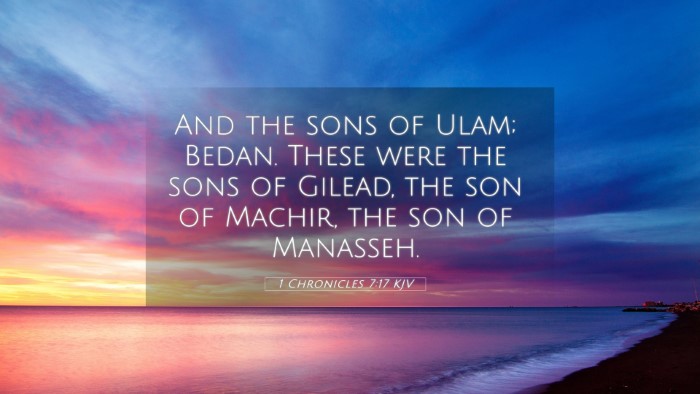Understanding 1 Chronicles 7:17
1 Chronicles 7:17 states: “And the sons of Ephraim; Shuthelah and Bered his son, and Tahath his son, and Eleadah his son, and Tahath his son.”
This verse is embedded within the genealogical record of the tribes of Israel, specifically the descendants of Ephraim. Understanding this verse requires consideration of its implications in the context of Biblical genealogies, the significance of the descendants, and the thematic connections that are formed through the lineage mentioned.
Genealogical Significance
-
Matthew Henry Commentary: Matthew Henry emphasizes the importance of genealogies in the Bible, illustrating how they serve to establish the identities and histories of the people of Israel. He notes how the specific mention of each descendant, such as Shuthelah, Bered, and Tahath, signifies the ongoing narrative of God’s covenant with His people.
-
Albert Barnes Notes: Barnes highlights that genealogies not only help trace physical lineage but also signify spiritual inheritance. Each name mentioned carries the weight of expectation and legacy, reflecting the roles these descendants play within God’s plan for Israel.
-
Adam Clarke Commentary: Clarke provides further insights on the historical context of these genealogies, reiterating that they serve a dual purpose: to acknowledge human lineage while concurrently affirming divine providence in the sustenance of the tribes throughout generations.
Thematic Connections and Cross-References
Several thematic connections emerge from 1 Chronicles 7:17 when considering its place in the broader narrative of the Bible. Here are some relevant cross-references that illuminate its meaning further:
-
Genesis 48:14-20: This passage discusses Jacob's blessing of Ephraim and Manasseh, reflecting the significance of Ephraim in Israel’s lineage.
-
Joshua 16:1-10: This explains the inheritance of the tribe of Ephraim, linking their genealogical significance to the land they possess.
-
Numbers 26:28-37: This portion discusses the tribe of Ephraim's numbers and family divisions, underscoring the importance of understanding each clan's contribution to the nation of Israel.
-
1 Chronicles 5:24: Here, the descendants of Ephraim are recognized in the context of their military exploits and faithfulness to God, emphasizing their role in the history of Israel.
-
Luke 3:36: This New Testament genealogy connects back to the Old Testament, highlighting a lineage that ultimately points to Jesus Christ, revealing God's redemptive plan through generations.
-
Hebrews 11:32-34: The author of Hebrews references the faithful acts of those from Ephraim and other tribes, linking their historical narratives with the themes of faith and obedience.
-
Jeremiah 31:9: This verse evokes the future restoration of Ephraim, showcasing God’s merciful promise for His people which echoes the themes of hope found in genealogical records.
-
Revelation 7:8: The mention of the tribe of Joseph, which Ephraim is a part of, in apocalyptic literature connects back to the promises made to the descendants of Joseph throughout scripture.
Application of Cross-Referencing Techniques
When studying 1 Chronicles 7:17, employing tools for Bible cross-referencing can enhance understanding significantly. Here are various methods and tools to consider:
-
Bible Concordance: A biblical concordance helps to locate verses and their related themes quickly, making it easier to see connections between verses like 1 Chronicles 7:17 and others in both the Old and New Testaments.
-
Bible Cross-Reference Guide: Utilizing guides designed to show thematic and direct connections between verses will deepen your study and bring additional insight.
-
Cross-Reference Bible Study: Engaging in this type of study involves examining verses that relate to 1 Chronicles 7:17 to uncover more significant themes found in scripture.
-
Identifying Connections: Looking for links between similar genealogies in the Bible, such as those in Matthew 1 and Luke 3, can illustrate the continuity of God's plan through generations.
-
Comparative Study: This involves analyzing the parallels found within the genealogies of different texts and how they contribute to the overarching narrative of scripture.
-
Comprehensive Bible Cross-Reference Materials: Utilizing materials that emphasize the interconnectedness of biblical texts aids in understanding the full message of God’s word.
Conclusion
In summary, 1 Chronicles 7:17 not only provides a snapshot of Ephraim's lineage but also serves as a gateway to understanding broader theological themes present throughout the Bible. By cross-referencing this verse with others, readers can engage in a deeper exploration of Scripture, tracing the connections and implications that arise among various Biblical texts. This inter-Biblical dialogue enriches one's spiritual and intellectual understanding of God’s work through history, culminating in the ultimate fulfillment found in Jesus Christ.



